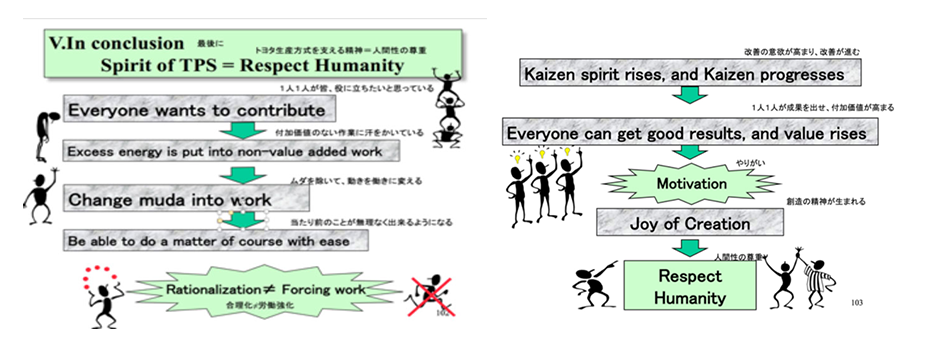Image Source: Toyota Motor Corp
Few principles are more essential to lean than Respect, a potentially gooey notion, yet one which translates into a set of concrete principles and practices that form a foundation for a true lean culture. Tackling lean with integrity requires a pragmatic approach to “respect” through a comprehensive set of well-thought out and commonly understood practices. In the past week a number of excellent articles have been published; and this piece attempts to weave together the common threads of these recent pieces with a history of other helpful writings about this core lean tenet.
An article of faith that informal virtually every reference respect is the notion that it’s not what you say, but what you do that counts—that respect for people goes far beyond gestures and tokens of etiquette or protocol. Creating a culture of respect results from a mindful, coordinated, explicit and practical approach, notes Kevin Meyer. He states in his recent article “The Importance of Respect for People in Problem-Solving” that:
“Respect for people is not simply treating people in your organization in a positive manner. It is challenging them to grow, providing them the tools, training, and experiences to do so, and creating an environment where mistakes and failures are allowed and even encouraged. Respect extends beyond the immediate organization to suppliers, customers, and the community as a whole.”
He notes that this calls for more than good intentions, citing a recent HBR article on the prerequisites for teams to be great at problem-solving: psychological safety and cognitive diversity. Such qualities form an environment in which respect can be manifest, he notes, and ties this to lean nicely in his final comment:
“Embracing a diverse set of problem-solving behaviors while providing an environment where they can be safely expressed and explored is respect for people. It is intentionallyworking to optimize their potential, which leads to positive transformation, improvement, and value for the customer.”
And so one can identify any number of formal, practical actions that companies put into place to ensure that its workers are learning together. Consider this great piece in which Katie Anderson describes the practical actions that the Japanese Oishi Accounting firm takes to engage and respect its employees. More than a decade ago the small company made a commitment to change its culture, with the goal of being a great place to work. They believed that doing so would be better for its employees, and in turn would delight its customers as well. Her detailed piece lists a myriad of ways the company has operationalized this goal. A longer list of 15 includes:
- Checking on your appearance—turn to someone next to you and make sure that their clothes are in order. Then do “happy gymnastics”(framing your face with your fingers in “V”, kicking one foot out and smiling).
- Recitation of an old text –everyone in the company has to memorize a long passage from an old text within the first month of their employment. Staff are chosen at random each day to recite
- “Happy speech” –a small toy is thrown around the circle and the person who catches it must share something that made them happy in the past 24 hours. The goal is about creating a positive mindset.
- “Home home” or “shower of praise” –once a week a name is chosen out of a basket to be the recipient of praise. Everyone goes around the circle and shares something nice about the person. The praised person often gets emotional to receive so many compliments or positive messages at one time.
- “#1 Declaration” –each employee chooses the one thing that she or he wants to be the #1 in Japan. This goal is put on their business cards too. During the chorei, they go quickly through the circle and share what their #1 aspiration is, while the rest of the group repeats “onegaishimasu” (“please”) at the end of each person’s goal.
By the way, in a separate, earlier, piece, Katie limns the history of respect for people by tracing its emergence as a countermeasure to the problem of backsliding of quality improvements at Toyota. Without a sustained commitment to the social elements of this socio-technical system, without humble leaders showing respect for individuals, and making it safe to surface problems, then key elements such as standardized work and takt time would never take root and flourish.
Here’s a simple way to define respect, from Jim Womack’s 2007 e-letter titled Respect for People:
“Over time I’ve come to realize that this problem solving process is actually the highest form of respect. The manager is saying to the employees that the manager can’t solve the problem alone, because the manager isn’t close enough to the problem to know the facts. He or she truly respects the employees’ knowledge and their dedication to finding the best answer. But the employees can’t solve the problem alone either because they are often too close to the problem to see its context and they may refrain from asking tough questions about their own work. Only by showing mutual respect – each for the other and for each other’s role – is it possible to solve problems, make work more satisfying, and move organizational performance to an ever higher level.”
Practicing respect is an animating force of lean leadership that colors how one coaches and develops people. “The lean ideal for respect is pretty clear: make every effort to understand each other and take responsibility for others’ problems, develop every person’s problem solving autonomy, involve every person in designing their own jobs and managing their own work and partake of the joy of creation when ideas become a reality,” notes Michael Balle in How do You Define Respect for People?. A key piece of that is viewing “respect” as a teachable discipline: “respect for the development of the person’s autonomy to solve their own problems, which is essentially teaching problem solving.”
This take also animates Michael’s book Lead With Respect. Among his pieces that elaborate on this are a two-part interview with the protagonist of the book detailing how lean tools support the principle of respect, and a webinar on the topic.
Many pieces explore the risks of promoting a soft topic like respect and the potential unintended consequences of enforcing this as a dogma. This excellent and counterintuitive Balle Does Being Sensei-ed Show Respect for People reflects how sensei can be both tough and respectful simultaneously—and how the act of pushing workers to develop their problem solving skills may be uncomfortable, but over the long run are designed with the idea that people want to discover how to work better. Another take on this is explored in Does Respect for Humanity Mean the Same as Respect for People by Balle in which he notes, “The management imperative is to create an environment where people can be creative and truly enjoy their work.”ce
Indeed, many leaders find short cuts to ensuring that respect remains their key focus. In a terrific piece last week Mark Graban took us back to a key 2012 Pittsburgh Post-Gazette article about Paul O’Neil’s leadership of Alcoa in which he would ask three key questions about the workplace:
- “Can I say every day I am treated with dignity and respect by everyone I encounter without respect to my pay grade, or my title, or my race, or ethnicity or religious beliefs or gender?
- Am I given the things I need – education, training, tools, encouragement – so I can make a contribution to this organization that gives meaning to my life?
- Am I recognized for what I do by someone I care about?”
Mark’s Post includes a wealth of other links on this theme, including his own poll on these questions he conducted through Twitter. And Mark neatly wraps up all these pieces with this reminder:
“He’s not saying we should be respectful for the sake of being respectful. There’s nothing wrong with being respectful, and I wish it were always the default way of operating. I think Toyota also makes a case for why “respect for people” is the best long-term business strategy if we’re looking to be successful and sustain success.
It’s win/win… being respectful and being successful go hand in hand. Is it possible to be successful without respect for people? Sure… for a while. But is that sustainable?”
By the way, to continue unveiling the nesting doll of links to prior articles about respect, check out these links from a previous Post by Mark on this topic.
Key to note that for long-time lean thinkers the notion of respect becomes so deeply ingrained that they cannot help but reflect on it in any setting. Consider this lovely piece here in which Bruce Hamilton shares his experience as a lean patient. Lying in his hospital bed at a find Boston health care facility, he just can’t help train his eyes on the system around him and ways that it can be improved. In his case he observes ways that the work of the heathcare workers can be improved so that they can do their job easier, which in turn should free them to help patients even more. For him the key question is, “Who cares for the care givers?”
That’s clearly evident in this column How to go to the Gemba in which John Shook says:
“When going to see, lean thinking mandates (yes, mandates) that we show respect to all the people, especially the people who do the value-creating work of the business, the activities that create value for customers. When visiting any gemba, through showing respect for the workers we also show respect for customers and the company, analyzing for evidence of disconnects between stated objectives, perhaps expressed in the organization’s “true north” visions statements, versus what we actually observed at the gemba.”
This David Verble Post builds on Shook’s comments, proposing that one of the most powerful ways of showing respect is by simply listening attentively to others in the present. He observed Fujio Cho do this, noting “He was fully present and connected to the person speaking as though there was no more important use of his time.” Such an approach was part of communication habits that formed a culture of respect.
And to wrap up, let’s not forget that there’s one hugely tangible way to show respect, as presented in Want to Respect Your People? Share the Profits?, in which Orry Fiume posits “When a company chooses to follow a Lean Strategy that embodies the “Respect for People” principle, what better way to put teeth into it than making everyone a partner in the business?”
Such a long Post, and yet not nearly long enough to do this subject….respect. I realize that this list is subjective and insufficient, so readers, please share your favorite articles, quotes, books, and other resources on this vital topic!






